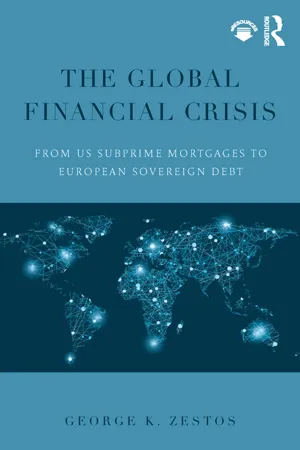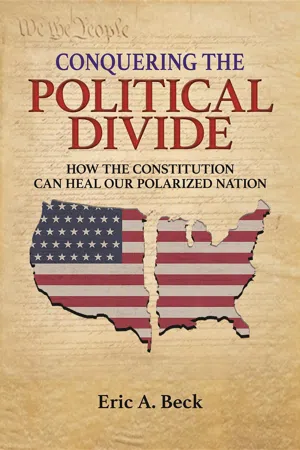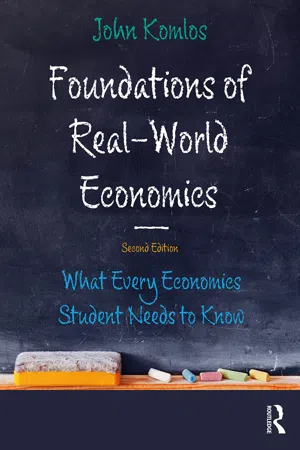Causes of the 2007–2009 Financial Crisis
The 2007-2009 financial crisis was caused by a combination of factors, including the housing market bubble, subprime mortgage lending, excessive risk-taking by financial institutions, and inadequate regulation and oversight. These factors led to a widespread collapse in the housing market, a surge in mortgage defaults, and a domino effect that spread throughout the global financial system, resulting in a severe economic downturn.
8 Key excerpts on "Causes of the 2007–2009 Financial Crisis"
...7 The 2007–2009 Financial Crisis In the previous chapter the unit of analysis was a near thirty-year period. Here I focus on a shorter time period and one relatively specific event, the 2007–2009 financial crisis. In many respects this chapter is a postscript to the previous one, but it focuses not on general trends, but on one specific event: the near collapse of the financial system. The focus is even more specific in that I am primarily concerned with the technological, structural, and cultural context that made the crisis possible. While I briefly summarize the sequence of events that led to the crisis, I do not try to provide an exhaustive description of these, nor do I try to cover the consequences of the crisis including the severe economic recession that followed. What Happened? There are many accounts of the events that led to the financial crisis of 2007–2009. 1 The basic story is that there was a market bubble in housing prices. Demand for housing was greater than the number of houses available and prices went up. Because of the rising prices investors started speculating by buying houses and then reselling them at a higher price. Construction companies started building more houses in anticipation that they could be sold at a sizeable profit. Since the value of people's houses was increasing, many borrowed against their equity to meet expenses or increase their standard of living (Redmond 2007). Eventually the supply of houses became too great for the demand, prices dropped, and the bubble burst. Speculators and home builders began lowering their prices to get rid of houses before prices declined further. The value of family-owned residences also declined to the point where the market value of a house was often less than the mortgage that was owed. Such bubbles are not uncommon and perhaps inherent in market economies (Minsky 1986)...
- eBook - ePub
Restoring Financial Stability
How to Repair a Failed System
- Viral V. Acharya, Matthew P. Richardson, Viral V. Acharya, Matthew P. Richardson(Authors)
- 2009(Publication Date)
- Wiley(Publisher)
...PART One Causes of the Financial Crisis of 2007-2009 Matthew Richardson T here is almost universal agreement that the fundamental cause of the financial crisis was the combination of a credit boom and a housing bubble. It is much less clear, however, why this combination led to such a severe crisis. The common view is that the crisis was due to the originate-to-distribute model of securitization, which led to lower-quality loans being miraculously transformed into highly rated securities by the rating agencies. To some extent, this characterization is unfortunately true. That is: • There was a tremendous growth in subprime loans. Many of these loans were highly risky and only possible due to the clever creation of products like 2/28 and 3/27 adjustable rate mortgages (ARMs). • Moreover, this growth in subprime lending was only possible due to the ability of securitization to pass on the credit risk of loans faced by the lender to the end user investor in asset-backed securities (ABSs). • The end user was willing to invest only because the rating agencies had rubber-stamped a large portion of these securities as AAA by creating a chain of complex structured products. Chapter 1, “Mortgage Origination and Securitization in the Financial Crisis,” looks at these issues in detail and lays out principles and proposals for future regulation. Of course, while this chapter focuses on the mortgage market and—in particular—on subprime loans, the discussion holds more generally. There was a plethora of cheap loans made throughout the economy, and many of the same issues of deteriorating loan quality are at play in these other markets. Credit card debt, car loans, “covenant-lite” corporate bonds, and leveraged loans for leveraged buyout (LBO) transactions were all trading at historically low spreads over risk-free bonds. Like the past fate of the subprime market, many of these loans are now facing increasing default rates...
- eBook - ePub
- John Raymond LaBrosse, Rodrigo Olivares-Caminal, Dalvinder Singh(Authors)
- 2020(Publication Date)
- Informa Law from Routledge(Publisher)
...CHAPTER 1 THE FINANCIAL TURMOIL OF 2007–20XX: CAUSES, CULPRITS AND CONSEQUENCES George G. Kaufman INTRODUCTION The ongoing financial crisis that started in the summer of 2007 has been characterised by the failure or near-failure of large banks in a wide range of countries, including banks in most, if not almost all industrial countries; the need for direct government or central bank liquidity and capital assistance to enable bank, non-bank financial and non-bank non-financial firms to keep operating (which may involve at least temporary partial or full nationalisation); the “credit crunch” in the form of slow growth or reductions in both bank and non-bank lending to firms and households; loss of faith in financial markets and institutions; and sharp declines in stock prices and personal wealth. This has spilt over to the macro-economy through an adverse feedback loop, causing low or negative real growth and high unemployment globally and igniting or magnifying an otherwise “normal” recession. In the US, the crisis also resulted in sharp increases in mortgage defaults and foreclosures and a potential shift in national economic structure for large firms from greater emphasis on market regulation and private ownership to greater emphasis on government regulation and quasi-public ownership. The period threatened to be the most significant peace-time economic and financial crisis in most countries since the 1930s...
- eBook - ePub
The European Union Illuminated
Its Nature, Importance and Future
- A. El-Agraa(Author)
- 2015(Publication Date)
- Palgrave Macmillan(Publisher)
...It therefore suffices to confine the exposition to only these two. 7 Turner begins by cautioning that it is only with hindsight that a fairly compelling and broadly agreed explanation of the crisis can be set out. He then states that the crisis arose from a combination of macro-imbalances and financial market developments and innovations. The first have grown rapidly in the past decade. The second have been in progress over three decades, but accelerated over the past ten to fifteen years, partly under the stimulus of macro-imbalances. And de Larosière et al. reinforce this by arguing that the crisis is the outcome of a ‘complex interaction of market failures, global financial and monetary imbalances, inappropriate regulation, weak supervision and poor macro-prudential oversight’. 8 They earlier elaborate that ample liquidity and low interest rates were the main culprits in the present crisis, but that financial innovation intensified and accelerated the outcomes of excess liquidity and rapid credit expansion. Strong macro-economic growth since the mid-1990s created an illusion that permanent and sustainable high levels of growth were not only possible but also likely. Due to both inflation and interest rates being low, the volume of credit accelerated, and central banks, especially the US Federal Reserve, did not see a need for tightening monetary policy. Instead of raising the prices of goods and services, excess liquidity led to soaring asset prices. Such monetary policies then led to increasing imbalances in global financial and commodity markets. It seemed natural to surmise that the very low US interest rates must have contributed to the creation of the widespread housing bubble. Both Turner and de Larosière et al. are of the opinion that the bubble was fuelled by unregulated, or insufficiently regulated, mortgage lending and by complex securitization financing techniques...
- eBook - ePub
The Global Financial Crisis
From US subprime mortgages to European sovereign debt
- George K. Zestos(Author)
- 2015(Publication Date)
- Routledge(Publisher)
...2 CAUSES OF THE US SUBPRIME MORTGAGE CRISIS Introduction Several years have passed since the end of the recession caused by the subprime mortgage crisis in the US. The causes of the crisis are still subject to debate, and it seems they will always be disputed, especially among proponents of opposing politico-economic ideologies. The main disagreement between these opposing ideological groups is in regard to the degree of government intervention in the economy and, more specifically, the housing market. Most researchers, nonetheless, are convinced that both government and market failures played a major role in the formation of the US subprime mortgage crisis and a large majority of analysts agree that many factors were responsible. What follows in this chapter is a brief analysis of the most important factors that fermented the crisis. All of these factors are discussed and critically analyzed, though they are not presented in order of significance. The dot-com and the corporate scandals crises of 2000–3 The dot-com and corporate scandals crises that occurred at the turn of the twenty-first century were preceded by the longest economic expansion in modern US history, the decade of the 1990s. This expansion brought the unemployment rate down to 4 percent, the inflation rate to about 2 percent, and generated federal government surpluses for the years 1998–2001. 1 Several authors support the view that the US subprime mortgage crisis has its roots in the expansionary US monetary and fiscal policies, adopted to cope with the dot-com and corporate scandals crises, and the negative climate that followed the terrorists attacks of September 11, 2001. The Fed, after a sequence of incremental cuts, drove the federal funds rate, its main monetary policy instrument, from 6.5 percent down to 1 percent, a 42-year record low. The US federal government reduced taxes and increased expenditures during this period to prevent a further deepening of the anticipated recession...
- eBook - ePub
Conquering the Political Divide
How the Constitution Can Heal Our Polarized Nation
- Eric A. Beck(Author)
- 2019(Publication Date)
- Author Academy Elite(Publisher)
...4: The Root Cause of the 2008 Financial Crisis These two entities—Fannie Mae and Freddie Mac—are not facing any kind of financial crisis . .. The more people exaggerate these problems, the more pressure there is on these companies, the less we will see in terms of affordable housing. 98 —Congressman Barney Frank (D-MA), former ranking member of the House Financial Services Committee, September 2003 The Bush administration’s regulators stood by as the financial industry engaged in some of the most catastrophic and irresponsible practices seen in the history of financial markets. 99 —Center for American Progress, October 2010 Since the onset of the financial crisis in September 2008, there has been ample time to reflect on what led up to the collapse of financial markets and who was responsible. The root causes of this crisis were many, and they will not be explored in detail in this book. However, an honest accounting of history will show that politicians from both major political parties share a portion of the blame for their actions, and likewise for inaction, across the more than twenty-year period leading up to the crisis. Some individuals and institutions deserve more blame than others, and Presidents Clinton, Bush, and Obama own their respective fair share of the blame by contributing to the crisis in different ways. For example, President Bush (a Republican) should have been more prudent when directing Fannie Mae and Freddie Mac to increase the percentage of subprime mortgages acquired from originators. Mr. Bush could also have been more vocal about the systematic risks introduced by passage of the Financial Services Modernization Act of 1999 (aka, the Graham-Leach-Bliley Act [GLBA]). This Act, as signed into law by President Clinton (a Democrat), repealed key provisions of the Glass-Steagall Act of 1933 that created regulatory barriers between the insurance, commercial banking, and investment banking businesses...
- eBook - ePub
Foundations of Real-World Economics
What Every Economics Student Needs to Know
- John Komlos(Author)
- 2019(Publication Date)
- Routledge(Publisher)
...The roots of the crisis can be found in the “The Secondary Mortgage Market Enhancement Act of 1984,” which allowed private banks to securitize mortgages. The Financial Crisis Inquiry Commission rightly blamed Greenspan and Bernanke the most: “the Federal Reserve’s pivotal failure to stem the flow of toxic mortgages, which it could have done by setting prudent mortgage-lending standards. The Federal Reserve was the one entity empowered to do so and it did not.” However, others blundered as well: [f]inancial institutions made, bought, and sold mortgage securities they never examined, did not care to examine, or knew to be defective; firms depended on tens of billions of dollars of borrowing that had to be renewed each and every night, secured by subprime mortgage securities; and major firms and investors blindly relied on credit rating agencies as their arbiters of risk. 95 The commission concluded that: The captains of finance and the public stewards of our financial system ignored warnings and failed to question, understand, and manage evolving risks within a system essential to the well-being of the American public. Theirs was a big miss, not a stumble . . . To paraphrase Shakespeare, the fault lies not in the stars, but in us. 96 The Bailout: A Crisis Obama Wasted The Great Recession followed the subprime mortgage bubble with a substantial decline in income, increases in nonemployment, a spectacular rise in foreclosures, pain, and suffering of the U.S. population. The investment in residential housing was cut by half between 2006 and 2009, which put a $400 billion hole in aggregate demand. Net investment in tangible assets (which includes housing) declined even more, dropping by 78%, or $614 billion. 97 This was a major calamity that had not been seen in the U.S...
- eBook - ePub
- D. Basu, V. Miroshnik(Authors)
- 2015(Publication Date)
- Palgrave Macmillan(Publisher)
...7 The Economic Crisis of 2008: Causes and Solutions Cause of the financial crisis of 2008 ‘An open, competitive and liberalized financial market can effectively allocate scarcer resources in a manner that promotes stability and prosperity far better than government intervention,’ Henry Paulson, the US Treasury Secretary said in Shanghai in March 2007. Now this sounds like a big joke given the fact that both the US and UK governments have nationalized banks and financial institutions in order to avoid a complete meltdown of their financial system. On September 7, 2008 the US government nationalized two huge US banks, Fannie Mae (Federal National Mortgage Association) and Freddie Mac (Federal Home Mortgage Corporation). That means in effect that the government is paying for the losses of the shareholders and investors in these banks – $5.4 trillion of guaranteed mortgage-backed securities (MBS) and debt outstanding. These liabilities are equal to all the publicly held debt of the USA. Both the USA and the UK, along with their European partners, have allocated a vast amount of money to support their struggling banks. This program is designed to buy a mountain of defaulted housing loans and other worthless assets from banks and finance companies and will cost an estimated $700 billion to $1 trillion (www.mckinsey.com/.../McKinsey_Private_Banking_Survey). This money will come from taxpayers, most of whom are ordinary workers. In the USA alone, it amounts to taking around $2500 from every US citizen – and giving it to the banks and finance companies (www.oecd.org/.../G20reportLTFinancingForGrowthRussian). This money could have been used for healthcare, improved education, scientific research, social welfare, environmental protection, or other socially useful purposes...







